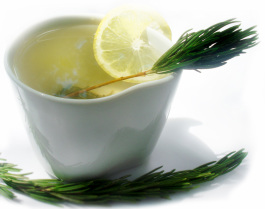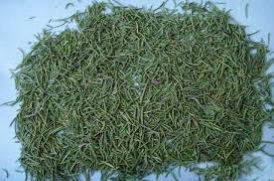
Scientific name: Rosmarinus officinalis
Common name: Rosemary
Family: Labiatae
Organic rosemary oil extract has originated from Germany, and has benefited society ever since. Being native to the Mediterranean, it is a fragrant herb with leaves that resemble needles. There are 5 different ways rosemary extract can be produced. These methods include: dried rosemary leaves by acetone extraction, extraction of rosemary leaves by means of supercritical carbon dioxide, a partially deodorized ethanolic extract of rosemary, a deodorized ethanolic extract of rosemary, or from extract which is decolourized and deodorized rosemary extract obtained by a two-step extraction using hexane and ethanol.
In regards to the food, cosmetic, pharmaceutical and therapeutic, and personal use industry, rosemary extract is the best alternative for sodium benzoate. This product acts against dandruff, enhances hair growth, and is suited to protect against oxidation in food products. These food products may contain meat products, sauces, marinades, sauces, condiments, and salad dressings. Rosemary Extract also makes great a spectacular herbal tea!
For a product to be considered green, the product has to:
-promote good indoor air quality
-be durable and have low maintenance requirements
-incorporate recycled content
-use natural and/or renewable resources
-use low “embodied” energy (energy required to produce and transport materials)
-not contain CFCs, HCFCs or other ozone depleting substances
-not contain highly toxic compounds
-be obtained form local resources & manufactures
-be easily reused, are biodegradable and readily recycled

Rosemary extracts are prepared through the extraction process from dried rosemary leaves. This can be done using ethanol, acetone, and/or hexane and supercritical carbon dioxide. Out of the 5 methods, extracting the rosemary through supercritical carbon dioxide is most common. In this process, dried rosemary leaves are dissolved in carbon dioxide, then the carbon dioxide fraction obtained is precipitated. The next step would to be to deodorize the raw extract by supercritical carbon dioxide to obtain concentrated amounts of the essential oil which includes carnosol and carnosic acid. Finally, to convert the extract into powder or liquid-oil form, the substance has to be homogenized and mixed with food-grade carriers. The carnosol and carnosic acid levels are approximately 30%.
This procedure results in superior quality natural oil that contains the most properties of rosemary than the other methods. After extracting, less than 4% of sunflower seed oil is added to increase the solubility when the substance is mixed with oils or fats. Then, a tiny amount of GMO-free tocopherols are added to enhance the properties of anti-oxidants of the oil.

Rosemary extract is considered to be a green alternative of sodium benzoate because instead of creating neurogenic diseases and promoting cancer, rosemary extract has proven to do the exact opposite. Rosemary extract can be sold as an organic flavouring substance as well as a preservative because it contains antimicrobial compounds like sodium benzoate. It is an herb extract, not synthesized in laboratories like sodium benzoate, so it is potentially more beneficial to the health of humans. The preservative quality of this alternative is significantly better than sodium benzoate as well. The rosemary seed extract properties include: oil solubility, natural anti-oxidant, low flavor, and can be used in any desired dosage. With proper storage, the shelf life of this extract can exceed 5 years. As mentioned previously, the characteristics that a product has to have in order for it to be considered green is met by the rosemary extract. Not only does this product sell as a preservative and flavouring, it can be sold to the cosmetic or personal care industries. This is because the primary chemicals found in this extract, carnosol and carnosic acid, help protect and support brain function, fight cancer, reduce allergies, and reduce the risk of hypertension.
Health Effects and Precautions
If the consumer has epilepsy, the camphor in the herb can potentially trigger seizures. Also, when the rosemary leaves are used in large quantities, it may cause a coma, spasm, vomiting, pulmonary edema in which all could be fatal. A pregnant or breastfeeding woman as well as an individual with high blood pressure should also avoid the use of products containing this substance. In pregnant women, the rosemary might stimulate menstruation; thus, affecting the uterus and causing a miscarriage.
Impact of environment due to the manufacture, use, and disposal of rosemary extract
Manufacture
Rosemary plants are usually grown under dry land conditions in South Africa. The highest quality oil extracted from the plant is the flowering top, which would be cut frequently for rapid regrowth. The leaves need to be artificially dried under a temperature of 40 degrees celcius to reduce loss of flavor and maintain the green colour. The transportation of the rosemary extract needs to be at a specific humidity to prevent the loss of properties of these extracts. It is discovered that moisture, heat, oxygen, and light destroy those properties, reducing the shelf life. Due to this herb being naturally grown, there is no severe impact to the environment. Although there may be concerns to the artificial drying of the rosemary plant, it uses less energy to create this substance than to manufacture a product that includes sodium benzoate.
Use & Disposal
The use of rosemary extract does not show any significant, if any, impact of the environment. Rosemary extract is not regulated as hazardous waste by the federal Environmental Protection Agency (EPA); however, it might be regulated in certain countries, states, or provinces.



 RSS Feed
RSS Feed